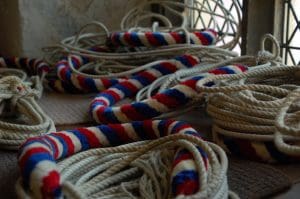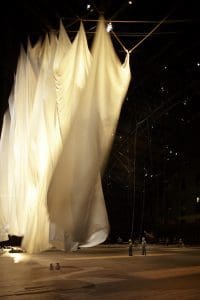Interior Landscapes: An Interview with Ann Hamilton
Ann Hamilton is a visual artist known for her large-scale multimedia installations, flowing fabrics and the immersive atmosphere of her work. Hamilton has filled Pier 9 along the Delaware River with a field of spinning curtains, creating an interior landscape within which, suspended in time, a visitor can be both lost and held. habitus, organized by the Fabric Workshop and Museum and part of the 2016 Fringe Festival, is on view now, free and open to the public during scheduled hours. habitus also includes a corresponding exhibition of historical objects—including literary commonplace books, textile sample books, dolls, and needlework portfolios—at The Fabric Workshop and Museum from Saturday, September 17, 2016 to Sunday, January 8, 2017. We caught up with Hamilton earlier this summer to discuss her interest in fabric, Philadelphia’s textile history and the character of Pier 9.
FringeArts: What was the inspiration for this installation?
Ann Hamilton: The Fabric Workshop and Museum began as a place for making. Initially they made a home for students, interns and artists to silkscreen. Pulling color across a screen transformed the surface of a white cloth. The process repeated made a whole room and changed the way you feel. It is an institution that like FringeArts trusts artists and believes in the power of acts of making and transformation and this is an inspiration.
More specifically, the Fabric Workshop and Museum is rooted in the history of cloth, textile related processes and productions. They make a place for artists to explore and extend their vocabularies, to ask “what-if?” My history also begins with a cloth on my lap and so this project began in response to our shared legacy and collaborations by exploring Philadelphia based textile collections and local industries who have been in production over several generations. Littlewood Dyers does vat dying of raw fiber for a whole host of clients including the intense purple in a Disney costumes and the deep blue/black of Navy wools. The several hour tour of Littlewood, a highlight along with the loom and weaving production at Langhorne Carpet Company—where the scale the reeling of thread and the looms that have been in operation for decades—are inspiration for several project to come. Watching a raw material become a single thread, join other thread to become a warp or weft of a cloth or carpet holds for me all the possibilities for making; sewing and writing are for me two parts of the same hand. In the former the hand directs with subtle sureness a needle through a cloth up, down, up then down again and again and again, a running succession, the trail of thread making one out of what was once two. The pace is regular like walking, like writing. It keeps the body busy so the mind can wander.

Ann Hamilton, (habitus • doll ) Doll, 1800–1820. Papier-mâché; Wood; Linen; Cotton; Paint; Silk. Courtesy of Winterthur Museum, Garden & Library, Gift of Katherine Gahagan, Michael H. du Pont, and Christopher T. du Pont in memory of A. Felix du Pont, Jr., 1999.19.1.
I have long been drawn to textile sample books—the cloth fragments, the hand written notes, the folio sized pages, their gorgeous unintentional compositions, and find in them a relation to the fragments of writing, inspiring to the collector, intentionally gathered into a commonplace book. The liquidity of the copied out text in the handwritten books, or the cut and paste of more contemporary versions are sources stitched into thinking just as the bits of cloth pasted into the textile books imagine a larger cloth or garment. We were shown beautiful swatch, sample, and dye books in the Philadelphia Museum of Art’s collection, Winterthur Library, and Philadelphia University whose archives contain so much of the city’s textile history. The project will include examples from each of these collections. As well as commonplace books from Rosenbach Library, the Philadelphia Free library and others. The history and tactility of these objects began the project.
FA: What was the process from initial idea to installation?
Ann Hamilton: A project always begins with an intuition, a hunch, a half formed question – these direct the research and through an associative and often circuitous process the project forms from trying to understand them. The challenge is to trust the process and remain open to change, to keep putting your needle down into the cloth and see what is drawn up from underneath. I suppose it is a little like fishing. You have to wait and see what you will find and in waiting you have to pay attention to everything.
FA: How does scale influence this process?
Ann Hamilton: The field of spinning curtains in the pier depends upon scale—the interior is a landscape within which you can be both lost and held. It uniquely invites a sociability, an access, suspends a sense of time. I love working in large spaces – their large volumes seem to breathe air into our own interior volumes. They make us feel both larger and smaller.
FA: What is compelling to you about a space like Pier 9?
Ann Hamilton: My approach to a site is always to find how to work with what it is, to orient towards its light, to touch its perimeters, to engage but not to fill it, to make a condition for attention. I begin by walking the space—trying to listen to it through my feet. It probably seems obvious but at Pier 9 one can’t help but be drawn by the tracks that run down its middle—the feeling of its dampened surface, the glimmer of the Delaware through the door slits, the sense of it as a place of transition—of storage—a space that is always changing.
FA: How do the pulleys work?
 Ann Hamilton: The curtains spin horizontally but the propelling motion transfers the upstroke and down stroke of flax Change Ringing ropes via wheel and pulley. Steve Shultz is masterminding the relations of weight, velocity, pulley size and system drag. We have had several test runs in the space and together visited the change ringers at Saint Martins.
Ann Hamilton: The curtains spin horizontally but the propelling motion transfers the upstroke and down stroke of flax Change Ringing ropes via wheel and pulley. Steve Shultz is masterminding the relations of weight, velocity, pulley size and system drag. We have had several test runs in the space and together visited the change ringers at Saint Martins.
Although there are no bells in this project and change ringing is not a practice that I know except as a listener and a visitor, the bells are often rung to sound the hour and the half hour, their sound signals across a landscape the pattern and coordination of the hand and a group of people working together—standing in a circle facing each other, and it penetrates all other sounds. Though the ropes are visible only to the ringers in the bell tower, they are beautiful to see and to touch. At the pier, with the ropes hung in pairs, there is an element of cooperation, of motion and sound generated when everyone is working together.
Wool threads are twisted into three strands of a bell rope to form a thick plush center. This thickened section is called a sally – as in ‘to sally forth’ coming from the latin ‘salire’ which means to leap. It marks the strokes and protects the change ringers from the chafing on the linen. I love that the hand, in holding this leaping rope where wool binds to linen plies plant with animal.
On the upstroke the wool travels out of the ringers HAND, on the down stroke it pulls back toward the ringer’s chest. THE HAND, listening to the ear must know when to pull, when to hold and when to let go. The pattern of letting go and catching, is the sounding, is the counting time of the body. This hearing is how we touch at a distance.
FA: What is the environment you wish to create for this installation? And what do you see yourself fine tuning as you put the finishing touches on it?
Ann Hamilton: The project in the Workshop space is focused on material artifacts based in the scale of the book and blanket, the needle and thread, pen and paper, the close at hand. In contrast, though interior, the project at the Pier is at the scale of a landscape. I hope that the quiet more solitary study and commune with objects in the one gives way to motion and physical engagement in the other. The scale and relationships between text and textile is a thread between the two installations.
All projects are “finding.” We will learn from the project, tweak and change right up to the opening and then we will learn from it—will learn what it is—what it needs, how it works. Projects are never finished until they are taken down and then one works still as a fuller understanding grows only over time.
FA: How do you see the visitor experiencing the installation?
 Ann Hamilton: The surroundings of oversized curtains, the feeling of the plush threaded ropes in hand, the rhythm of the body pulling up and down, the reel of words slowly unfolding in a continuum, like the river itself, the changing light and air together have the possibility of making a space to be in, to enter into like you enter a book, you don’t know where it will take you but you enter anyway. What is important is not only where it takes you – it is also always where you take yourself and how you allow yourself to respond, to feel, and to be. In the end this relationship is individual but my hope is that the circumstances are a sharing. The process is an act of finding.
Ann Hamilton: The surroundings of oversized curtains, the feeling of the plush threaded ropes in hand, the rhythm of the body pulling up and down, the reel of words slowly unfolding in a continuum, like the river itself, the changing light and air together have the possibility of making a space to be in, to enter into like you enter a book, you don’t know where it will take you but you enter anyway. What is important is not only where it takes you – it is also always where you take yourself and how you allow yourself to respond, to feel, and to be. In the end this relationship is individual but my hope is that the circumstances are a sharing. The process is an act of finding.
When we read and fall into the permissions of the page the rhythm of the eye crossing successive lines of writing sends us off and out into another world, the world of the words and what they stir inside us. This outward pull is, conversely, a falling in. Falling is the motion of the mind wandering, is the concert between the reader and the thing read. We disappear into it and it into us perhaps no differently than we are folded between cloth—hidden and revealed—touched. We become the book and the book becomes us, as do our houses, and our clothes, but these we mark with inhabitation – by worn knees and scratched floors, between body and material the shaping is mutual, is visible. This project is the shaping that is the air of motion around us—the air that, like cloth, is always touching us.




